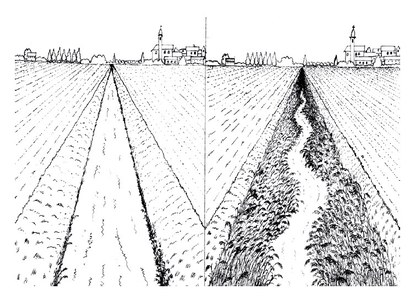Action B7 Vegetation management
Canal riverbeds are potentially rich in vegetation: the wet portion typically houses hydrophytes, in particular aquatic plants, such as water buttercup (Ranunculus aquatilis), which thrive at the bottom, and typical floating water plants, such as duckweed (Lemna minor) and yellow water lily (Nuphar lutea; smaller the wet portion of smaller canals can be especially invaded by common reed (Phragmites australis) and other plants.
The foot of the bank can accommodate marsh plants (helophytes) that typically grow among reeds, while herbaceous plants potentially tend to grow in the medium-high portion of the shore, which is more arid, due to sporadic submersion. Finally, the upper part of river banks, being less humid, is more suitable for the growth of species and bushes, which due to scarcity of nutrients, are typical herbaceous plants of dry grasslands.
The favorable environmental effects related to the presence of vegetation in the riverbed along canals are countless: aquatic plant community provides, for example, food resources, shelter environments and substrates to a rich variety of vertebrates and invertebrates, and can therefore accommodate a large number of species and allow the development of more stable animal and plant communities along canals.
 The presence of aquatic plants within the riverbed also favours natural water purification and so mitigates the effects of any pollutants.
The presence of aquatic plants within the riverbed also favours natural water purification and so mitigates the effects of any pollutants.
The presence of aquatic plants at the foot of the bank has also beneficial effects against bank instability and can therefore reduce the need for river bank consolidation and recovery in the event of landslides.
On the other hand, the excessive development of aquatic vegetation along canals can reduce their hydraulic functionality and cause floods in the event of heavy rainfall. Reclamation Consortia therefore perform frequent vegetation maintenance (grass mowing or weeding) in order to prevent weed proliferation and so to prevent the flooding of the areas along canals.
Generally, these maintenance operations involve the almost full removal of vegetation, thus leading to the loss of ecological potentials associated with it, thus transforming canals in degraded ecosystems.
The project under question therefore intends to assess the environmental, hydraulic and economic benefits of different softer aquatic vegetation management techniques applied to sample stretches of canals managed by the Reclamation Consortium in charge.
A few management and related monitoring practices have been implemented, mostly with purely natural aims, without actually monitoring and evaluating the hydraulic consequences of the interventions, with non-exhaustive hydraulic assessments, without fully estimating pros and cons in an integrated manner from an environmental, hydraulic and economic point of view, aimed at designing more suitable multi-objective aquatic vegetation management practices.
